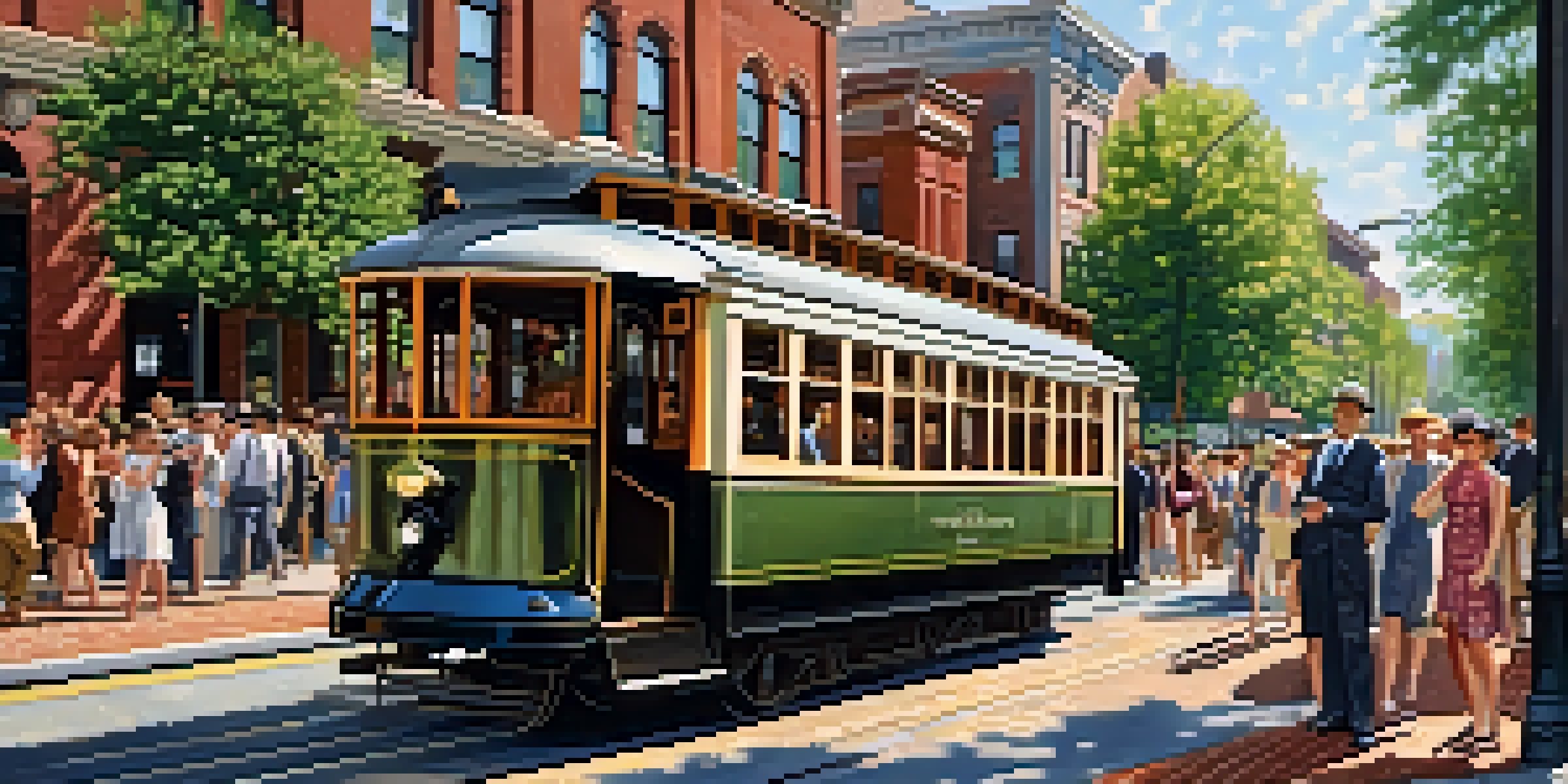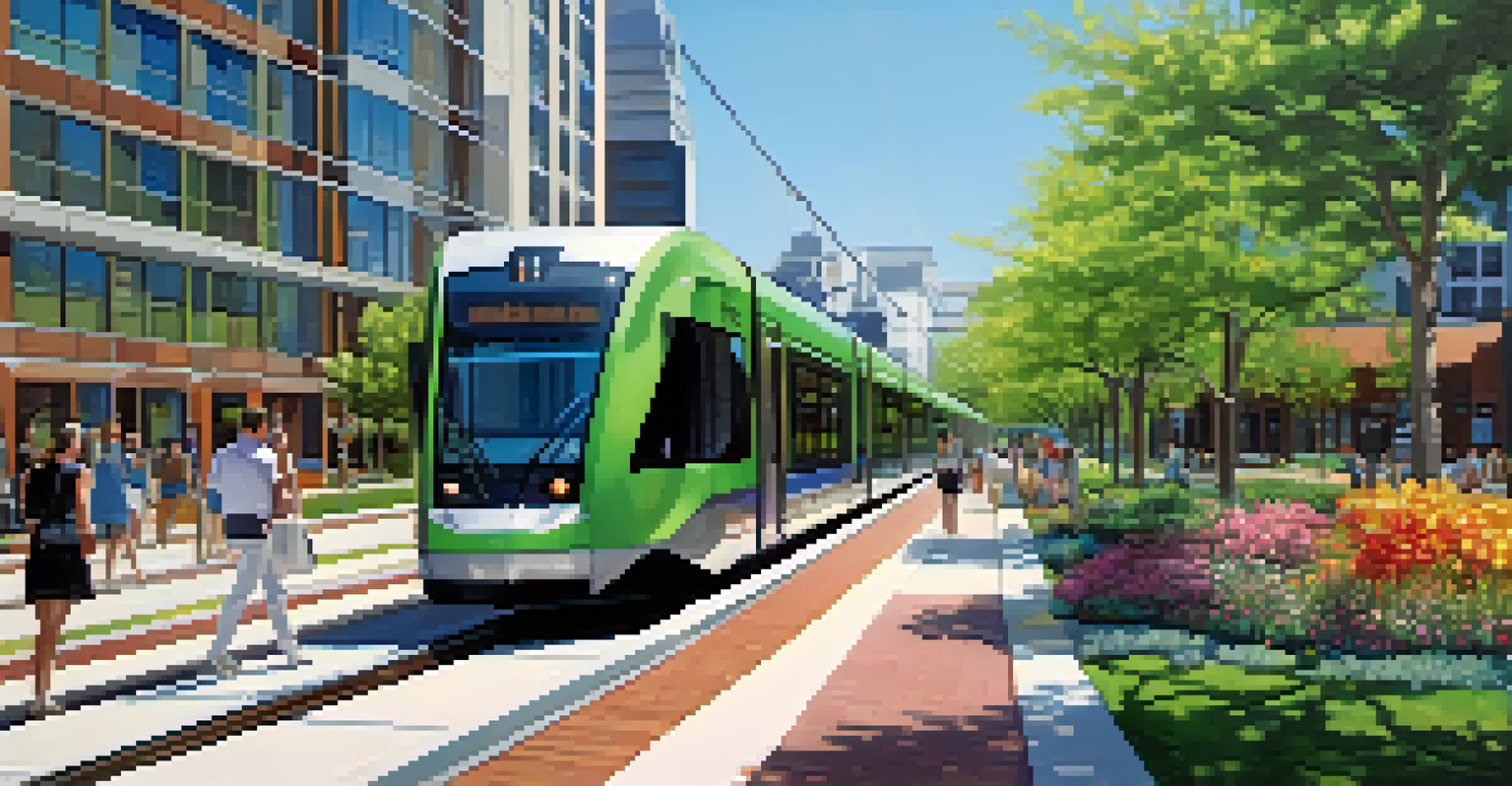Charlotte's Streetcar Era: A Transportation Revolution

The Birth of Charlotte's Streetcar System
In the late 19th century, Charlotte was a rapidly growing city, and its leaders recognized the need for an efficient transportation system. The streetcar emerged as a solution to connect neighborhoods and foster economic growth. This new mode of transport not only eased travel but also became a symbol of modernity for the city.
The streetcar is a vehicle for change.
The first streetcar line was established in 1886, featuring horse-drawn carriages, which were later replaced by electric trolleys. This innovation marked a significant shift in how residents navigated their city, allowing them to travel longer distances with ease. The streetcars quickly became a lifeline for Charlotte’s burgeoning population.
As the network expanded, it linked various parts of the city, making it possible for people to commute to work and access services. This accessibility contributed to the development of suburban areas, as more citizens were able to live further from their workplaces while still enjoying convenient transportation options.
The Impact on Urban Development
The streetcar system played a pivotal role in shaping Charlotte's urban landscape. As routes expanded, so did the city, with neighborhoods sprouting up along the lines. This development wasn't just about housing; it spurred the growth of shops, schools, and parks, fostering a sense of community.

Investors and developers took notice, pouring resources into areas serviced by streetcars. This created a vibrant urban fabric, where people could live, work, and play in close proximity. The streetcar not only facilitated movement but also laid the groundwork for a more interconnected city.
Streetcars Shaped Charlotte's Growth
The development of the streetcar system in the late 19th century significantly influenced urban development and connected various neighborhoods.
Moreover, the accessibility provided by streetcars encouraged a mix of socioeconomic classes to inhabit the same neighborhoods, promoting diversity. This blend of cultures and lifestyles enriched the community, making Charlotte a dynamic place to live and thrive.
Social Changes During the Streetcar Era
Charlotte's streetcar era coincided with significant social changes in the U.S., particularly in the early 20th century. As streetcars made transportation more accessible, they also played a role in the civil rights movement. This period saw increased mobility for African Americans, who could travel to new areas and access better opportunities.
Public transportation is the backbone of a sustainable urban future.
Social interactions began to shift, as different communities could engage with one another more easily. This increased interaction fostered a greater understanding among diverse groups, laying the groundwork for future social progress. The streetcar was not just a means of transport; it became a vehicle for change.
However, it’s important to acknowledge that this era also highlighted disparities. While streetcars improved access for many, they also reflected the racial and economic divides of the time. Segregation laws limited access for some, showcasing that while transportation can connect, it can also divide.
The Technological Advancements of Streetcars
The transition from horse-drawn to electric streetcars marked a remarkable technological leap for Charlotte. Electric streetcars became the backbone of urban transit, allowing for faster and more reliable service. This advancement not only improved daily commutes but also set a precedent for future transportation innovations.
These streetcars were equipped with powerful motors that significantly reduced travel time. For residents, this meant a more efficient way to navigate their city, leading to increased patronage and usage. The embrace of technology showcased Charlotte's willingness to adapt and innovate.
Transportation and Social Change
Streetcars not only enhanced mobility for residents but also played a role in fostering social interactions and advancing civil rights.
Moreover, the streetcar system paved the way for future developments in public transportation. The successes and challenges faced during this era informed later transportation policies and infrastructure projects, making it a foundational period in Charlotte's transit history.
Decline and Challenges of the Streetcar System
Despite its initial success, the streetcar system in Charlotte faced significant challenges by the mid-20th century. The rise of the automobile transformed how people traveled, leading to a decline in streetcar ridership. As cars became more affordable and prevalent, many residents opted for individual transport, leaving the streetcar system struggling.
Financial difficulties compounded these challenges, as maintenance costs for the aging infrastructure began to mount. The city faced tough decisions about whether to invest in repairs or let the system fade. Ultimately, the last streetcar line was discontinued in 1938, marking the end of an era.
This decline was indicative of a broader trend seen across many American cities. The shift in transportation preferences highlighted the need for urban planners to rethink public transit strategies to remain relevant in an evolving landscape.
Reviving the Legacy of the Streetcar
Despite the decline of the original streetcar system, Charlotte has sought to revive its legacy in recent years. In 2007, the city opened the LYNX light rail system, a modern take on public transit that echoes the historical streetcar routes. This initiative has rekindled interest in urban transit and encouraged a return to public transportation.
The light rail has been instrumental in reshaping the urban environment, promoting walkability and reducing traffic congestion. It serves as a reminder of the streetcar's impact and the importance of accessible transportation in urban planning. The revival reflects a growing recognition of public transit's role in sustainable city development.
Revival of Public Transit in Charlotte
The introduction of the LYNX light rail system in 2007 reflects a renewed commitment to accessible and sustainable transportation in the city.
Community engagement has also played a crucial role in this revival. Residents have voiced their support for expanded transit options, demonstrating a desire for a connected city. This renewed interest in public transportation underscores the enduring legacy of the streetcar era in shaping Charlotte's identity.
Looking Forward: The Future of Transportation in Charlotte
As Charlotte looks to the future, the lessons from the streetcar era remain relevant. Urban planners are increasingly focused on creating a balanced transportation ecosystem that integrates various modes of transit. This includes buses, light rail, biking, and walking paths, ensuring that all residents have access to efficient and sustainable transportation.
Innovations in technology, such as ride-sharing and electric vehicles, are also shaping the way people navigate the city. Charlotte is exploring these advancements while keeping the spirit of the streetcar era alive, focusing on connectivity and accessibility for all. The goal is to create a seamless travel experience that honors the past while looking ahead.

Ultimately, the future of transportation in Charlotte hinges on collaboration between city officials, residents, and businesses. By learning from the successes and failures of the streetcar era, Charlotte can build a more inclusive and efficient transportation network that serves the needs of its diverse population.